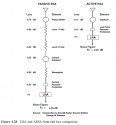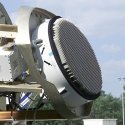Brumby
Major
Let me summarize what I've learned from the exchange we've had in the last week or so, as it relates to the difference between PESA/AESA, and how AESA radars in general are constructed.
An AESA radar can have just one transmitter, just like a PESA radar. The key difference is, that the high power amplifiers (HPA) are distributed throughout the antenna in an AESA architecture. Whereas, in a PESA radar, the HPA are not part of the antenna. Similarly, on the receive side the low noise amplifier (LNA) is distributed across the antenna in an AESA architecture. Whereas, in a PESA radar, there is one LNA that receives the signal input from the beamformer, typically per sub-array. Apparently, some modern PESA radars introduce separate receive channels with the LNAs inbuilt into the array, just like an AESA radar, equaling their advantages on the receive side. Examples proposed: Russian Bars/Irbis radar, American SPY-1 radar.
On both the transmit and receive side, AESA radars, just like PESA, started off using analog wavefront generation and analog beamforming. Ever since, there has been a steady trend towards going more digital and ever closer to the antenna, with the end goal being a digital array radar (DAR). Even though this trend appears to be associated primarily with AESA radars, I think it is to a large degree orthogonal to whether a radar is PESA or AESA. I say this, because there are exist partial implementations of the concept, such as digital beamforming on the receive side that both PESA and AESA can perform. Ditto for WFG. However, a true DAR does require HPAs to be part of the antenna, so AESA is the only right architecture to achieve this.
Some misconceptions that have been shown false, are:
- PESA must have one transmitter
- AESA has as many transmitters as there are TRMs.
Both systems can have just one transmitter. There are PESA that have 8 or more transmitters: SPY-1 and Cobra Dane to name the examples mentioned in the discussion here.
"Multiple beams": it is commonly advertised that a big advantage of AESA is forming multiple transmit beams. However, what seems to be overlooked or misunderstood, is that both PESA and AESA can and routinely do form multiple receive beams. From what I could gather, the common practice appears to be to send out one beam on transmit and then decompose it into smaller beams on the receive side, through either analog or digital beamforming. On my todo list is to understand how digital beamforming on the transmit side works. Would appreciate if someone can offer pointers.
In my opinion most of your conclusions are wrong because they are grounded on disparate pieces of radar technology rather than on the end product and how they actually operate.
For example, who the heck would build a functioning AESA radar based on a single TR? Just give me one example of such a moron and I promise I will not comment further.
AESA radar by design are superior to PESA on many fronts including on sensitivity. This is a well established fact from technical literature. I simply don't understand why it became such a long drawn argument over a well established fact. I can give you two sources
(1)


(2)
 )
)







